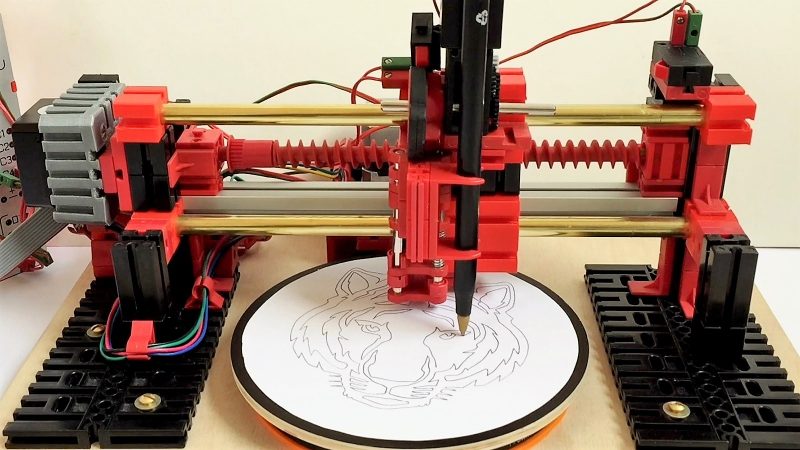Take apart a few old DVD drives, stitch them together with cable ties, add a pen and paper, and you’ve got a simple CNC plotter. They’re quick and easy projects that are fun, but they do tend to be a little on the “plug and chug” side. But a CNC plotter that uses polar coordinates? That takes a little more effort.
The vast majority of CNC projects, from simple two-axis plotters to big CNC routers, all tend to use Cartesian coordinate systems, where points on a plane are described by their distances from an origin point on two perpendicular axes. Everything is nice and square, measurements are straightforward, and the math is easy. [davidatfsg] decided to level up his CNC plotter a bit by choosing a polar coordinate system, with points described as a vector extending a certain distance from the origin at a specified angle. Most of the plotter is built from FischerTechnik parts, with a single linear axis intersecting the center point of a rotary drawing platform. Standard G-code is translated to polar coordinates by a Java applet before being sent to a custom Arduino controller to execute the moves. Check out the video below; it’s pretty mesmerizing to watch, and we can’t help but wonder how a polar 3D-printer would work out.
Have polar coordinates got you stumped? It can be a bit of an adjustment from Cartesian space for sure. It can be worth it, though, showing up in everything from cable plotters to POV fidget spinners and even to color space models.
















I’m interested in how they calculate the polar coordinates. I’d like to see my GRBL get an upgrade if it’ll do the trick fast enough. Hell, I’d be willing to try to implement it in my Smoothie if it works there.
θ = atan(y/x)
r = √(x²+y²)
θ = atan2(y,x)
Otherwise you run into infinite problems.
An implementation detail.
Should be quite trivial to do on Smoothieware, considering even SCARA (multiple interlinked polar arms) solution looks quite simple while it is much more complex than a single polar arm:
https://github.com/Smoothieware/Smoothieware/blob/edge/src/modules/robot/arm_solutions/MorganSCARASolution.cpp
The BEAN for background music if you from Lousina you understand what I mean.the machine is cool
theres another video that he finally draws a couple squares- looks like stright lines are a struggle for this type of plotting
When someone told Hank Ketchum (creator of Dennis the Menace) that they couldn’t draw a straight line; he responded “It’s the crooked lines that count!”.
B^)
Looks to me like they’re straight—it’s just the superimposed circles cause a well-known optical illusion.
Really? These squares look fine to me.
https://youtu.be/6gYmWcp-9eA?t=93
Ack, embed didn’t come with the time. About 1:34 is when it draws squares. Not sure what the weird pauses are about.
You’re right alfie. And Ren’s Hank, too. A famous artist once applied to a mentor who challenged him to draw something. He drew a nearly perfect circle. THAT takes a cartesian a lotta processing, as does a square for a polar coordinate type. Wanna draw a house? Maybe cartesian is best, unless it’s for a hobbit. Wanna draw a gal? Well polar coordinates can draw circles around cartesian, and circles are how many bioforms are so, uh… very nicely formed. (Vectrex!???? Gotta love those circles!)
So, don’t be a square. Look at Italian cars. Old, loved curvy Italian cars. Not those new things. The stealth was done w angles because computors could not then predict reflectice performance. New ones can and curves were sought and had.
Hauppage had a motherboard with a Risc and a Cisc chip. Pick your choose for the job at hand and boot. It’s not just the calculations. The iterations can swamp you when you try to translate that into the mechanics. 1 gun does not do it all. Sometimes you need to shoot around corners, that are curved. Blending the mechanics may be the barrier.
NICE JOB!
“and we can’t help but wonder how a polar 3D-printer would work out.”
Really? Such things have been in existence for some time.
Here’s the fruit of thirty seconds of google..
http://reprap.org/wiki/R_360
https://www.youtube.com/watch?v=gri16vi5D78
https://www.youtube.com/watch?v=lvcS7TT98mA
Many, many, more to be had if you care to look.
This guy Googles.
Wonder no more about polar 3d printers. Wonder at Google…
What about a polar coordinate mill?
Lathe.
LMAO! Good one!
Ponder the coordinate system in this cake cutter: https://www.youtube.com/watch?v=EOOtx4T7OcA
I wonder if the controller runs GLaDOS?
Is it like core XY but sort of polar?
A Polar bear is a Cartesian bear converted to Cylinder coordinates.
Actually, there’s a much simpler way to use polar coordinates. Back in the 30’s and 40’s, my sister and I had a “Hootnanny. See the page here:
https://www.google.com/search?q=Hootnanny&source=lnms&tbm=isch&sa=X&ved=0ahUKEwi3q4-MltbaAhXPoFMKHcpjDJMQ_AUIDCgD&biw=1280&bih=601#imgrc=F3yDKjmcDmGiqM:
Take out the disk and just drive the arms directly with two servo-motors, and you can move the effector to any x-y coordinate you like. I submitted this idea to Byte, ca. 1985 or so, but Carl Helmers was unimpressed.
I have a Visio drawing of the setup, but I don’t know how to post it here in this comment.
Ideally, you’d prefer the two servos to be concentric, but it’s probably easier, and just as effective, to place them close together, side by side.